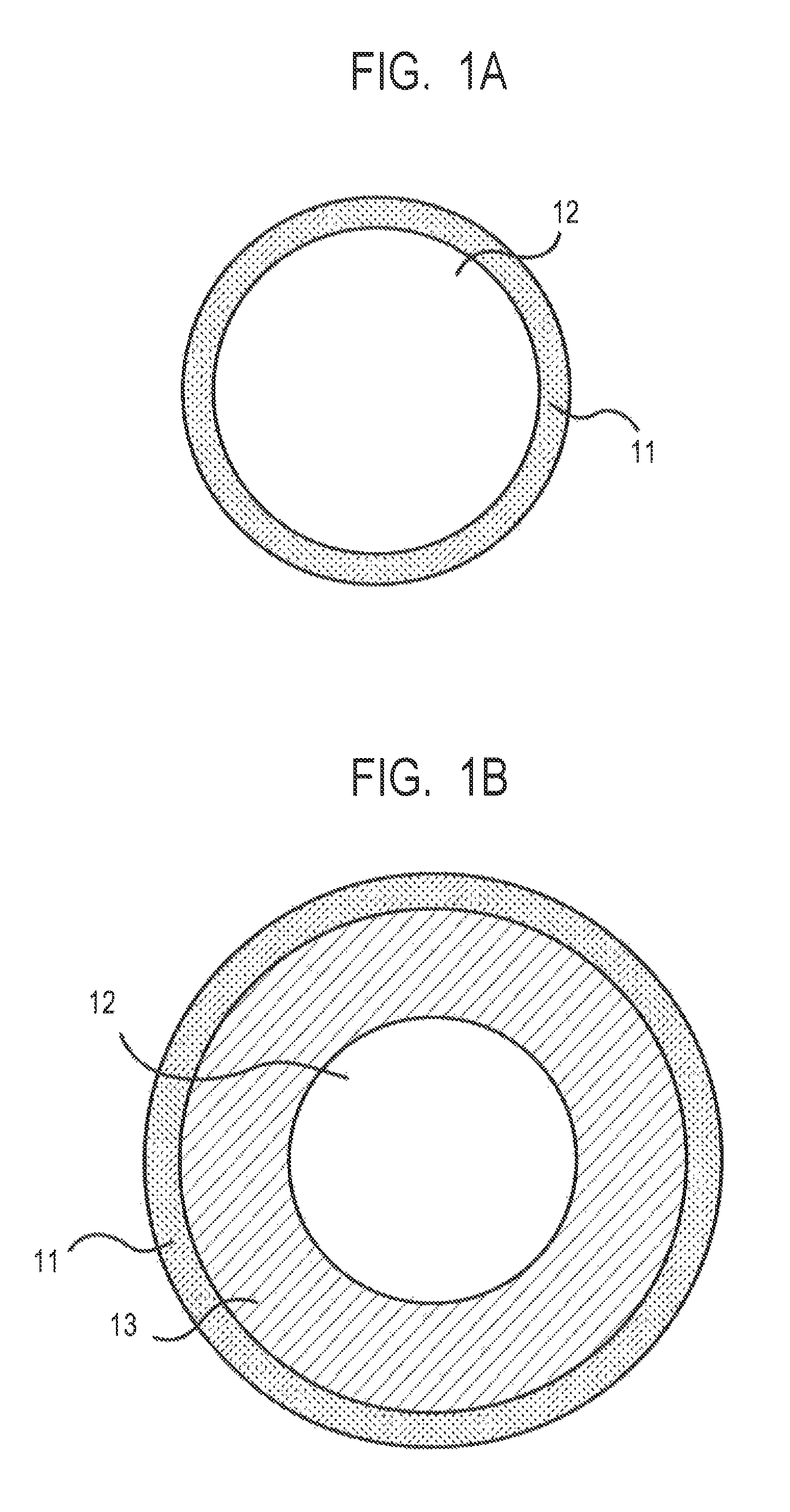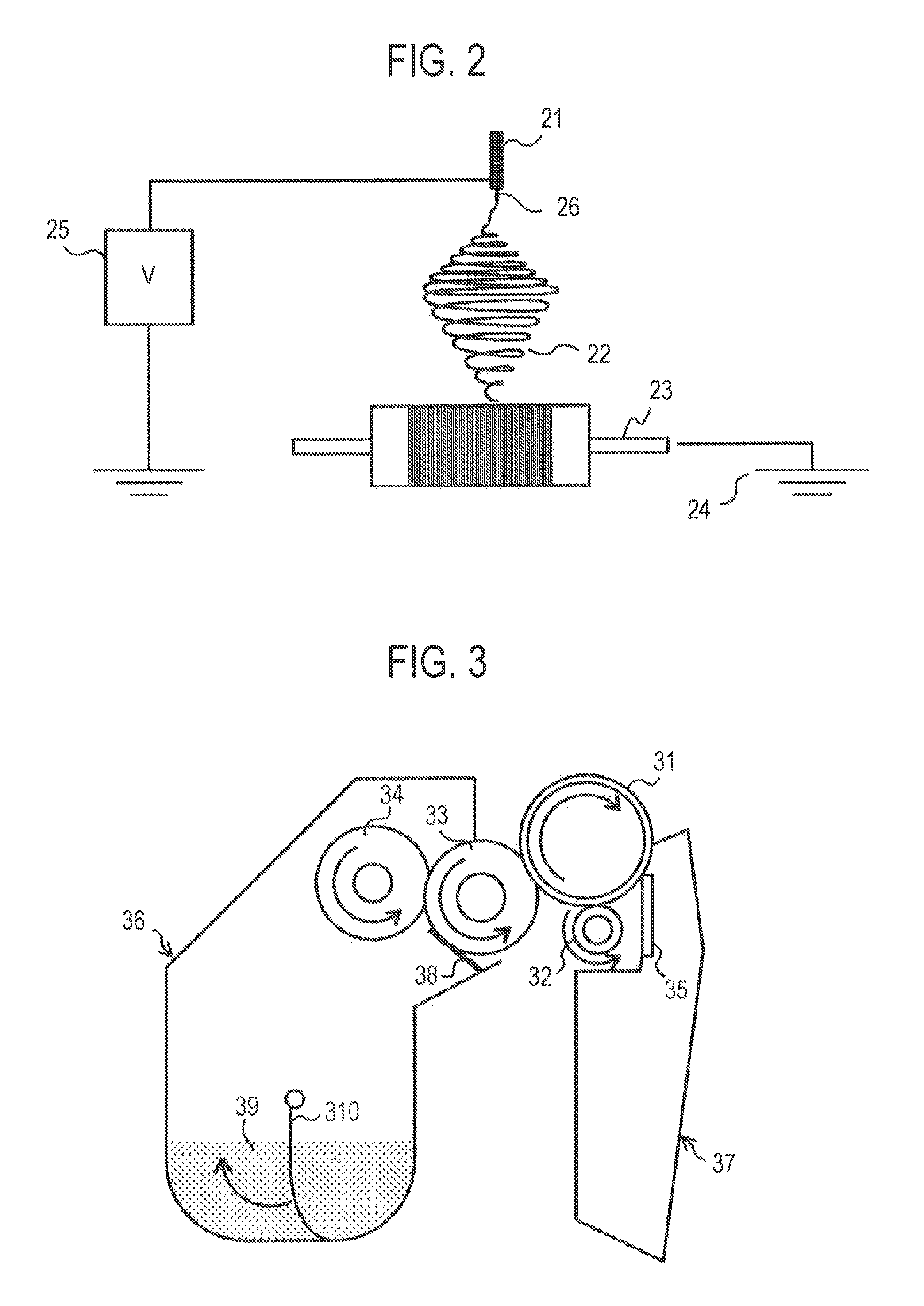Electroconductive member for electrophotography, process cartridge, and electrophotographic apparatus
a technology of electrophotography and electrophotography apparatus, applied in the direction of corona discharge, thin material handling, instruments, etc., can solve the problems of photosensitive member excessive charging, excessive discharge locally, image with blank dots, etc., and achieve high-quality electrophotographic images.
- Summary
- Abstract
- Description
- Claims
- Application Information
AI Technical Summary
Benefits of technology
Problems solved by technology
Method used
Image
Examples
example 1
1. Preparation of Unvulcanized Rubber Composition
[0107]An A-kneading rubber composition was obtained by mixing respective materials whose kinds and amounts were shown in Table 1 below with a pressure kneader. Further, respective materials whose kinds and amounts were shown in Table 2 below were mixed info 166 parts by mass of the A-kneading rubber composition with an open roll. Thus, an unvulcanized rubber composition was prepared.
[0108]
TABLE 1Blendingamount(part(s)Materialby mass)Raw materialNBR (trade name: Nipol100rubberDN219, manufactured byZEON CORPORATION)ElectroconductiveCarbon black40agent(trade name: TOKABLACK#7360SB, manufactured byTOKAI CARBON CO.,LTD.)FillerCalcium carbonate20(trade name: Nanox #30,manufactured by MARUOCALCIUM CO., LTD.)VulcanizationZinc oxide5accelerating aidProcessing aidStearic acid1
[0109]
TABLE 2Blendingamount(part(s)Materialby mass)CrosslinkingSulfur1.2agentVulcanizationTetrabenzyl thiuram disulfide4.5accelerator(trade name: TBZTD,manufactured by SAN...
examples 2 to 31
[0142]Electroconductive members were each produced in the same manner as in Example 1 except that; the fiber material used in the preparation of the application liquid for the layer of the network structural body was changed to a material shown in Table 4; and the conditions under which the application liquid for the layer of the network structural body was applied were changed as shown in Tables 5 to 8. Then, the members were similarly evaluated. Tables 5 to 8 show the results of the evaluations.
examples 32 to 34
[0143]Electroconductive members were each produced in the same manner as in Example 5 except that: an electroconductive elastic roller produced from an unvulcanized rubber composition obtained by mixing materials shown in Table 3 below with an open roll was used; and the injection time of the application liquid was changed, to an injection time shown in Table 8. Then, the members were similarly evaluated. Table 8 shows the results of the evaluations.
[0144]
TABLE 3Blendingamount(part(s)Materialby mass)Epichlorohydrin-ethylene oxide-allyl glycidyl ether100terpolymer (GECO) (trade name: EPICHLOMER CG-102,manufactured by DAISO CO., LTD.)Zinc oxide (ZINC OXIDE #2 manufactured by SEIDO5CHEMICAL INDUSTRY CO., LTD.)Calcium carbonate (trade name: SILVER W,35manufactured by SHIRAISHI CALCIUM KAISHA, LTD.)Carbon black (trade name: SEAST SO, manufactured by0.5TOKAI CARBON CO., LTD.)Stearic acid2Adipic acid ester (trade name: POLYCIZER W305ELS,10manufactured by DIC CORPORATION)Sulfur0.5Dipentamet...
PUM
 Login to View More
Login to View More Abstract
Description
Claims
Application Information
 Login to View More
Login to View More - R&D
- Intellectual Property
- Life Sciences
- Materials
- Tech Scout
- Unparalleled Data Quality
- Higher Quality Content
- 60% Fewer Hallucinations
Browse by: Latest US Patents, China's latest patents, Technical Efficacy Thesaurus, Application Domain, Technology Topic, Popular Technical Reports.
© 2025 PatSnap. All rights reserved.Legal|Privacy policy|Modern Slavery Act Transparency Statement|Sitemap|About US| Contact US: help@patsnap.com



